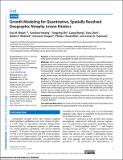| dc.contributor.author | Moult, Eric M | |
| dc.contributor.author | Hwang, Yunchan | |
| dc.contributor.author | Shi, Yingying | |
| dc.contributor.author | Wang, Liang | |
| dc.contributor.author | Chen, Siyu | |
| dc.contributor.author | Waheed, Nadia K | |
| dc.contributor.author | Gregori, Giovanni | |
| dc.contributor.author | Rosenfeld, Philip J | |
| dc.contributor.author | Fujimoto, James G | |
| dc.date.accessioned | 2022-06-22T18:39:21Z | |
| dc.date.available | 2022-06-22T18:39:21Z | |
| dc.date.issued | 2021 | |
| dc.identifier.uri | https://hdl.handle.net/1721.1/143549 | |
| dc.description.abstract | Purpose: To demonstrate the applicability of a growth modeling framework for quantifying spatial variations in geographic atrophy (GA) lesion kinetics. Methods: Thirty-eight eyes from 27 patients with GA secondary to age-related macular degeneration were imaged with a commercial swept source optical coherence tomography instrument at two visits separated by 1 year. Local GA growth rates were computed at 6-µm intervals along each lesion margin using a previously described growth model. Corresponding margin eccentricities, margin angles, and growth angles were also computed. The average GA growth rates conditioned on margin eccentricity, margin angle, growth angle, and fundus position were estimated via kernel regression. Results: A total of 88,356 GA margin points were analyzed. The average GA growth rates exhibited a hill-shaped dependency on eccentricity, being highest in the 0.5 mm to 1.6 mm range and lower on either side of that range. Average growth rates were also found to be higher for growth trajectories oriented away from (smaller growth angle), rather than toward (larger growth angle), the foveal center. The dependency of average growth rate on margin angle was less pronounced, although lesion segments in the superior and nasal aspects tended to grow faster. Conclusions: Our proposed growth modeling framework seems to be well-suited for generating accurate, spatially resolved GA growth rate atlases and should be confirmed on larger datasets. Translational Relevance: Our proposed growth modeling framework may enable more accurate measurements of spatial variations in GA growth rates. | en_US |
| dc.language.iso | en | |
| dc.publisher | Association for Research in Vision and Ophthalmology (ARVO) | en_US |
| dc.relation.isversionof | 10.1167/TVST.10.7.26 | en_US |
| dc.rights | Creative Commons Attribution 4.0 International license | en_US |
| dc.rights.uri | https://creativecommons.org/licenses/by/4.0/ | en_US |
| dc.source | ARVO | en_US |
| dc.title | Growth Modeling for Quantitative, Spatially Resolved Geographic Atrophy Lesion Kinetics | en_US |
| dc.type | Article | en_US |
| dc.identifier.citation | Moult, Eric M, Hwang, Yunchan, Shi, Yingying, Wang, Liang, Chen, Siyu et al. 2021. "Growth Modeling for Quantitative, Spatially Resolved Geographic Atrophy Lesion Kinetics." Translational Vision Science & Technology, 10 (7). | |
| dc.contributor.department | Massachusetts Institute of Technology. Department of Electrical Engineering and Computer Science | |
| dc.contributor.department | Massachusetts Institute of Technology. Research Laboratory of Electronics | |
| dc.contributor.department | Harvard University--MIT Division of Health Sciences and Technology | |
| dc.relation.journal | Translational Vision Science & Technology | en_US |
| dc.eprint.version | Final published version | en_US |
| dc.type.uri | http://purl.org/eprint/type/JournalArticle | en_US |
| eprint.status | http://purl.org/eprint/status/PeerReviewed | en_US |
| dc.date.updated | 2022-06-22T18:30:53Z | |
| dspace.orderedauthors | Moult, EM; Hwang, Y; Shi, Y; Wang, L; Chen, S; Waheed, NK; Gregori, G; Rosenfeld, PJ; Fujimoto, JG | en_US |
| dspace.date.submission | 2022-06-22T18:30:57Z | |
| mit.journal.volume | 10 | en_US |
| mit.journal.issue | 7 | en_US |
| mit.license | PUBLISHER_CC | |
| mit.metadata.status | Authority Work and Publication Information Needed | en_US |
